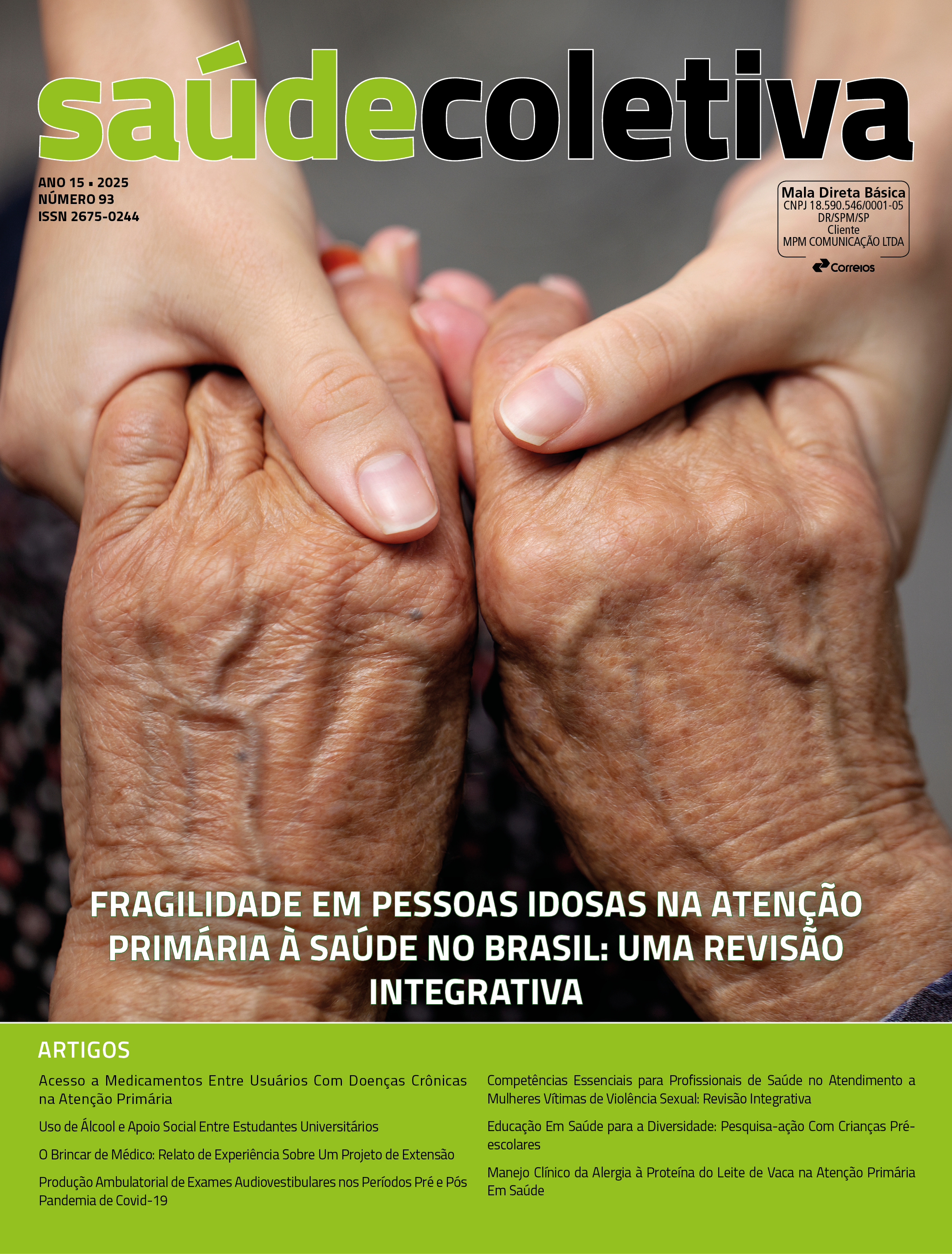Níveis de Atividade Física e Lombalgia Crônica Inespecífica
DOI:
https://doi.org/10.36489/saudecoletiva.2025v15i93p14638-14655Palavras-chave:
Lombalgia crônica inespecífica, Atividade física, ExercícioResumo
A Lombalgia Crônica Inespecífica (LCI) é uma das principais causas de incapacidade em todo o mundo, impactando negativamente a qualidade de vida das pessoas afetadas, gerando custos significativos para os sistemas de saúde. As evidências nas últimas duas décadas revolucionaram a condução da abordagem e tratamento dos casos, sendo que algumas arestas como os níveis de atividade física quanto às características das práticas, frequência, intensidade se apresentam vagas e pouco detalhadas de forma geral nas publicações da temática. O objetivo é investigar as relações entre níveis de atividade física e lombalgia crônica inespecífica. Desse modo, este estudo envolve uma revisão de literatura, de estudos publicados no período de 2012 a 2024 em inglês e português, com convergência com a temática e objetivo propostos. As plataformas Pubmed, SciELO, Biblioteca Cochrane, Scopus, Web of Science Physioterapia Evidence Database (PEDro). Foram selecionados, a partir dos critérios de inclusão e seleção, 35 estudos. Ficou evidente em relação aos níveis de atividade física que há necessidade de maior aprofundamento na temática pelos diferentes estudos, mas que há predomínio de indicações para práticas de intensidade moderada. A exposição gradual aos exercícios aeróbicos, de fortalecimento/resistência, de coordenação/estabilização e de controle motor, preferencialmente em estratégias multimodais como as estratégias combinadas com a cognição, bem como, a ioga, tanto realizados individualmente como em grupo, indicam benefícios sintomáticos e funcionais para pessoas com LCI.
Referências
Alzahrani, Hosam, et al. "The association between physical activity and low back pain: a systematic review and meta-analysis of observational studies." Scientific reports 9.1 (2019): 8244.
Grooten, Wilhelmus Johannes Andreas, et al. "Summarizing the effects of different exercise types in chronic low back pain–a systematic review of systematic reviews." BMC musculoskeletal disorders 23.1 (2022): 801.
Almeida, Matheus O., et al. "The McKenzie method for (sub) acute non‐specific low back pain." Cochrane Database of Systematic Reviews 4 (2023).
Frizziero, Antonio, et al. "Efficacy of core stability in non-specific chronic low back pain." Journal of functional morphology and kinesiology 6.2 (2021): 37.
Hayden, Jill A., et al. "Individual recovery expectations and prognosis of outcomes in non‐specific low back pain: prognostic factor review." Cochrane Database of Systematic Reviews 11 (2019).
Hayden, Jill A., et al. "Exercise therapy for chronic low back pain." Cochrane Database of Systematic Reviews 9 (2021).
Wong, Charles KW, et al. "Prevalence, incidence, and factors associated with non-specific chronic low back pain in community-dwelling older adults aged 60 years and older: a systematic review and meta-analysis." The journal of pain 23.4 (2022): 509-534.
Roren, Alexandra, et al. "Physical activity and low back pain: A critical narrative review." Annals of physical and rehabilitation medicine 66.2 (2023): 101650.
Alsufiany, Muhsen B., et al. "Non-specific chronic low back pain and physical activity: A comparison of postural control and hip muscle isometric strength: A cross-sectional study." Medicine 99.5 (2020): e18544.
Vadalà, Gianluca, et al. "Physical activity for the treatment of chronic low back pain in elderly patients: a systematic review." Journal of clinical medicine 9.4 (2020): 1023.
Li, Ying, et al. "Exercise intervention for patients with chronic low back pain: a systematic review and network meta-analysis." Frontiers in Public Health 11 (2023): 1155225.
Gordon, Rebecca, and Saul Bloxham. "A systematic review of the effects of exercise and physical activity on non-specific chronic low back pain." Healthcare. Vol. 4. No. 2. MDPI, 2016.
Fleckenstein, Johannes, et al. "Individualized exercise in chronic non-specific low back pain: A systematic review with meta-analysis on the effects of exercise alone or in combination with psychological interventions on pain and disability." The journal of pain 23.11 (2022): 1856-1873.
Saragiotto, Bruno T., et al. "Motor control exercise for chronic non‐specific low‐back pain." Cochrane Database of Systematic Reviews, 11, 2016.
Oliveira, Camila Teixeira de, Michel Kanas, and Marcelo Wajchenberg. "Treatment of non-specific chronic low back pain: resistance training with or without using weights?." Revista Brasileira de Medicina do Esporte 27.6 (2021): 603-609.
Elias, Juliana Pereira; Longen, Willians C. "Classification of low back pain into subgroups for diagnostic and therapeutic clarity." Coluna/Columna 19 (2020): 34-39.
Pérez-de la Cruz, Sagrario. "Influence and Relationship of Pain on Lumbar Biomechanics in a Young Adult Population with Non-Specific Low Back Pain." Sports 12.7 (2024): 190.
Carvalho, Flávia A., et al. "Fear of movement is not associated with objective and subjective physical activity levels in chronic nonspecific low back pain." Archives of physical medicine and rehabilitation 98.1 (2017): 96-104.
Morelhão, Priscila K., et al. "Physical activity and disability measures in chronic non-specific low back pain: a study of responsiveness." Clinical Rehabilitation 32.12 (2018): 1684-1695.
Herrero, Pablo, et al. "Effects of Lifestyle Interventions on the Improvement of Chronic Non-Specific Low Back Pain: A Systematic Review and Network Meta-Analysis." Healthcare. Vol. 12. No. 5. MDPI, 2024.
Marini, Mirca, et al. "Low back pain in healthy postmenopausal women and the effect of physical activity: A secondary analysis in a randomized trial." PLoS One 12.5 (2017): e0177370.
Griffin, Derek William, D. C. Harmon, and N. M. Kennedy. "Do patients with chronic low back pain have an altered level and/or pattern of physical activity compared to healthy individuals? A systematic review of the literature." Physiotherapy 98.1 2012: 13-23.
Owen, Patrick J., et al. "Which specific modes of exercise training are most effective for treating low back pain? Network meta-analysis." Br J Sports Med. 2020; 54(21):1279-1287.
Holtermann, A., Schnohr P., Nordestgaard B. G., Marott J. L. "The physical activity paradox in cardiovascular disease and all-cause mortality: the contemporary Copenhagen General Population Study with 104 046 adults." Eur Heart J. 2021; 42(15):1499-1511.
Longen WC. Efeitos do exercício aeróbico e da terapia manual sobre marcadores bioquímicos de lesão musculoesquelética e parâmetros funcionais em motoristas profissionais com lombalgia crônica inespecífica. Tese (Doutorado) - Curso de Programa de Pós-graduação em Ciências da Saúde, Universidade do Extremo Sul Catarinense, Criciúma; 2013. p. 106.
Longen WC; Brandolfi JA. Inatividade física na perpetuação do quadro sintomático e funcional da lombalgia crônica inespecífica. Rev Inspirar movimento e saúde. 2018;15(1):38-43.
National Institute for Health and Care Excellence. NICE guidelines: Low back pain and sciatica in over 16s: assessment and management. 2016.
Wewege MA, Booth J, Parmenter BJ. Aerobic vs. resistance exercise for chronic non-specific low back pain: A systematic review and meta-analysis. Journal of back and musculoskeletal rehabilitation 2018; 31(5): 889-99.
Vanti C, Andreatta S, Borghi S, Guccione AA, Pillastrini P, Bertozzi L. The effectiveness of walking versus exercise on pain and function in chronic low back pain: a systematic review and meta-analysis of randomized trials. Disability and rehabilitation 2019; 41(6): 622-32.
Malfliet A, Ickmans K, Huysmans E, et al. Best Evidence Rehabilitation for Chronic Pain Part 3: Low Back Pain. Journal of clinical medicine 2019; 8(7).
Sitthipornvorakul E, Klinsophon T, Sihawong R, Janwantanakul P. The effects of walking intervention in patients with chronic low back pain: A meta-analysis of randomized controlled trials. Musculoskeletal science & practice 2018; 34: 38-46.
Parreira P, Heymans MW, van Tulder MW, et al. Back Schools for chronic non-specific low back pain. The Cochrane database of systematic reviews 2017; 8: Cd011674.
Zhang Q, Jiang S, Young L, Li F. The Effectiveness of Group-Based Physiotherapy-Led Behavioral Psychological Interventions on Adults With Chronic Low Back Pain: A Systematic Review and Meta-Analysis. American journal of physical medicine & rehabilitation 2019; 98(3): 215-25.
Schemer L, Schroeder A, Ørnbøl E, Glombiewski JA. Exposure and cognitive-behavioural therapy for chronic back pain: An RCT on treatment processes. European journal of pain (London, England) 2019; 23(3): 526-38.
Andrioli IB.; Trombim PS.; Longen WC. Caracterização da Sintomatologia, Incapacidade e Potencial de Catastrofização de Trabalhadores com Lombalgia Crônica Inespecífica. Arquivos Catarinenses de Medicina, 2019; 20(2): 50-60.







